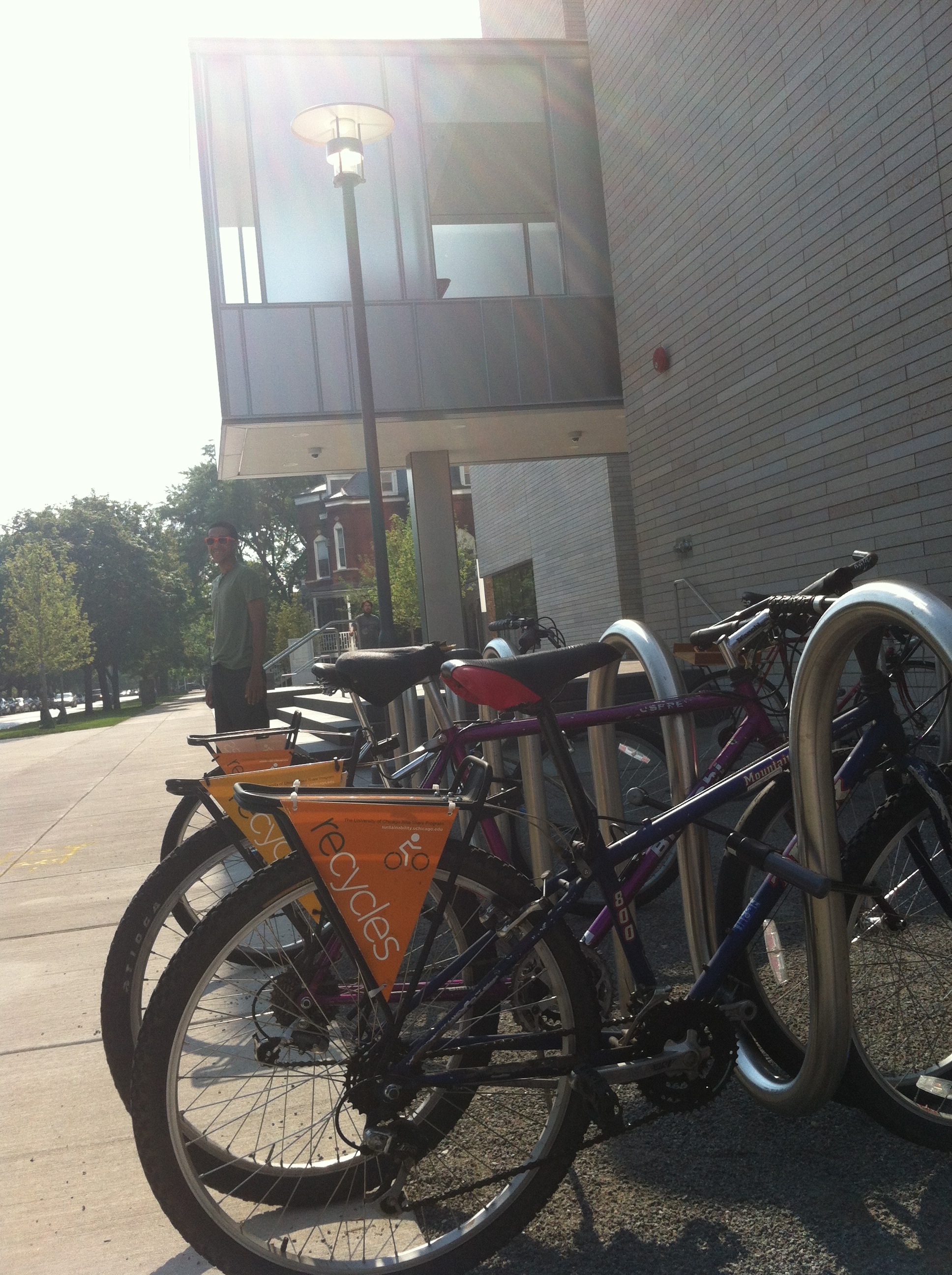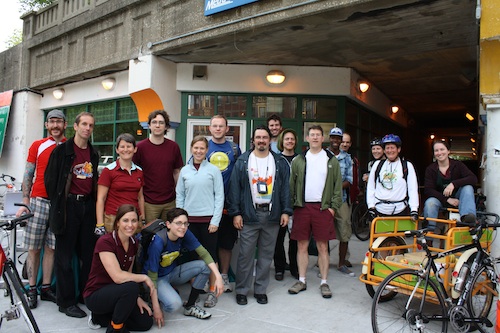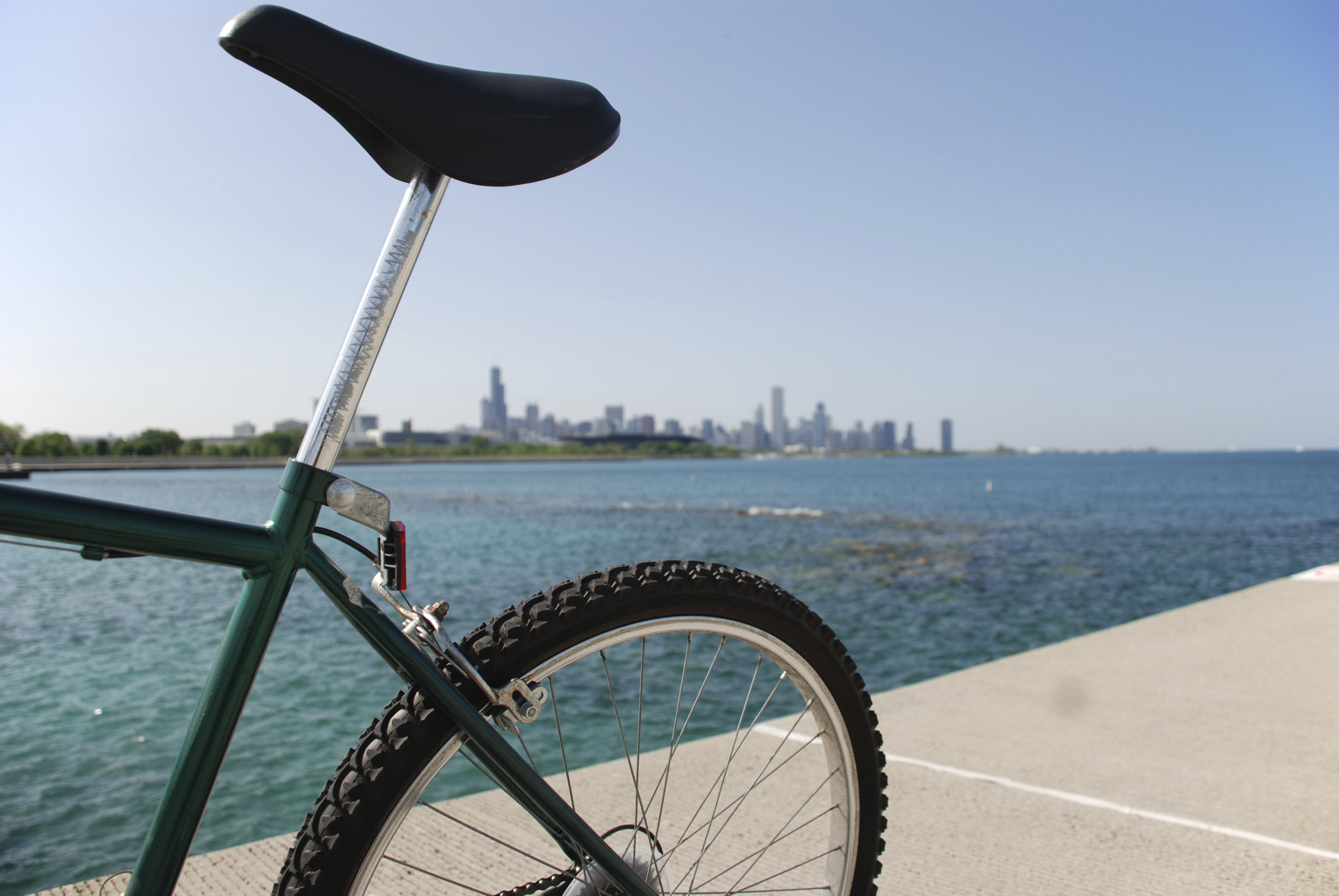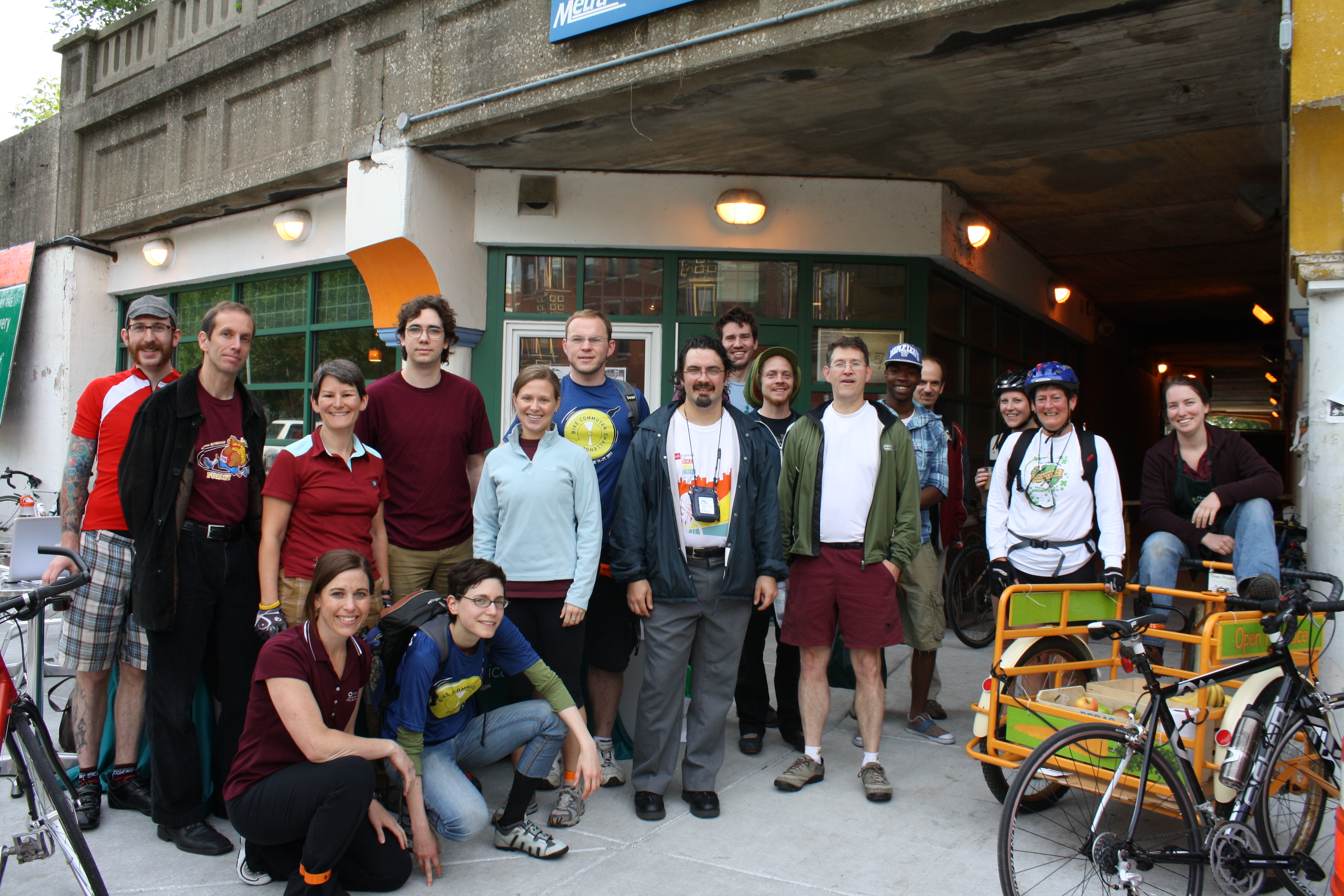As we continue to make improvements to the recycles bike share program, we’re proud to announce the opening of a new recycles station at the brand-new Reva and David Logan Center for the Arts, at 915 E 60th St. This station replaces the former South Campus Residence Hall/Edelstone station and is only 1.5 blocks away.
We apologize for any inconvenience resulting from the move, however we’re looking forward to serving students, faculty, staff, and alumni from the entire South campus area at this new station. Come check out one of the Logan Center for the Arts’ five bikes for a relaxing ride by the lake with a friend, a fun lunch break from work, or a jaunt downtown to explore Chicago’s galleries!
Welcome to our new monthly column: Ask Ignacio. Here at the Office of Sustainability, we get frequent questions from UChicago students, staff, faculty, and alumni about what is environmentally preferable. Plastic or paper? Hand dryers or paper towels? A friend told me I should only eat organic, is this true?
Each month will be dedicated to one of these questions. To submit a question, please email AskIgnacio@uchicago.edu. Think of it as sage advice (wink) for the scholar on the go.
And here we go; this is a question I was asked last week.
Q: Is recycling electronic waste a big deal? Does it really matter if I throw a laptop, batteries, or an iPhone in the trash?
A: In one word, yes. There are a couple major issues with electronic waste, or e-waste: resource conservation, leaking chemicals, and health hazards of improper recycling.
We can all accept that it is important to recycle as many materials as possible in order to conserve resources. This becomes far more critical when the materials being recycled are very rare. Electronics contain a large number of elements on the periodic table, from zinc and indium to rare earth metals like neodymium, dysprosium, and terbium. Over 60 elements are used in IT production processes; others include mercury, cadmium, beryllium, lead, bromine, gold, platinum, and lithium. The demand for many of these elements is greater than the current supply. (An interesting tidbit: there is more gold in one metric ton of circuit boards than in 17 metric tons of gold ore. Let that one sink in!)
Sometimes chemicals are not our friends. In fact, when not disposed of properly they can cause incredible damage to the environment and those who dwell in it (including us). This is easiest to explain with batteries. Over time, batteries begin to leak. What leaks out are some rather nasty acids (generally hydrochloric and sulfuric acids) that seep through the ground until they find their way to ground water. This contaminated ground water eventually finds its way to our water supply. Are you excited yet?
Last, but certainly not least, is what happens when e-waste is not recycled properly. Improperly disposed electronics frequently find their way to less developed countries. Workers will try to recover the metals and plastics under horrendous conditions. Plastics are frequently identified by burning and sniffing; after many components are smashed off the motherboard, they are burned in an attempt to recover as many of the metals as possible. All of this is frequently done by men, women, and children in close quarters full of toxic fumes. Was that a dark turn? Yes, but it is also true!
There are many other consequences of improper e-waste disposal, this post is just meant to highlight some of the larger concerns. I would encourage anyone reading this to research this further. This can get you started.
Luckily, there are a few things you can do right now. Batteries, including cell phone batteries, can be recycled rather easily. There are tube like receptacles for both battery types in Reynolds Club, Regenstein, dorms, and many other buildings. All computer-related electronics (CPUs, monitors, speakers, etc.) can be recycled through IT Services. For all other e-waste, the Office of Sustainability has you covered. We hold large e-waste collections twice a year, usually May and November. These collections accept all forms of e-waste. If there is any metal in it, we want it! We collected 36,000 lbs. of e-waste in the last May event. Yes, that is a lot of e-waste. Mark your calendars.
I hope this has been helpful. If your questions are keeping you wake at night, you are losing sleep and you just don’t know what to do anymore, your partner is about to leave you because they can’t handle your incessant environmental questions, I would love to help. Please submit your question by emailing AskIgnacio@uchicago.edu.
Forever yours,
Ignacio
How do office supply ordering habits relate to the environment? Frequent, small orders generate a lot of unnecessary packaging and waste. Instead of placing small orders daily or weekly, combine these into one large order. This will help to minimize packaging and truck deliveries to campus, to reduce the University's carbon emissions, and to meet campus-wide sustainability goals.
This month, Staples has put together a context in which all BuySite users can participate. Simply consolidate small office supply orders into an order of $50 or more between June 4, 2012 and June 22, 2012 and you'll be entered into a drawing for a pizza party for your department.
See the contest flyer for more details and ideas to help you consolidate.

Join Bike to Work Week 2012 by biking all or part of the way to work at least once during the week of June 9-15! This annual event attracted more than 200 participants last year who cycled over 4,500 miles. Register online for Team University of Chicago.
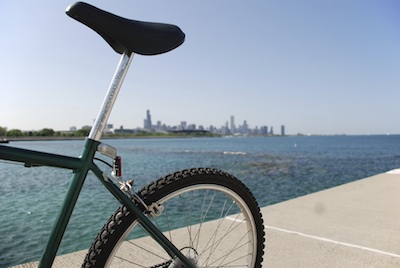
The perks of participating:
- Free pass to shower at Henry Crown the week of June 9 -15. Email Katie if interested in shower pass.
- Free pizza party for the department with the highest percentage of cyclists. The department with the largest increase in participation from last year will also be recognized, as will one of the newly participating departments with the highest percentage of cyclists.
- Bike Pit Stop on Tuesday, June 12th, from 6:30am - 9am outside Café 57 (1520 E. 57th Street)
- Fuel up with free refreshments, including fruit, breakfast bars, coffee, and ice tea.
- Free bike tune-ups from Blackstone Bicycle Works.
- Enter a raffle for the chance to win a one-year Zipcar membership, UChicago bike gear, a month’s supply of Clif Bars, and a free latte art class for you and your friends!
- Get cycling freebies from the Active Transportation Alliance.
- We’ll also take a group photo the morning of the Bike Pit Stop—time TBD!
Help spread the word about Bike to Work Week by posting this flyer in your department or office building. Please contact Katie with any questions about Bike to Work Week.
Not every kilowatt-hour is made equal. You may see your electric bill and think, “this is the amount of electricity I used, multiplied by the price, and with a few taxes added.” Actually, the true cost of electricity is not that simple. The amount of power you use is very important, but when is also important. Running an appliance at 1 pm is not the same as running it at 9pm. The reason for this is due to the way the power grid works.
- The power being used and the power being generated must be the same.
- Most forms of power generation require time to start up.
- The demand for electricity changes over the course of the year, as well as over the course of the day.
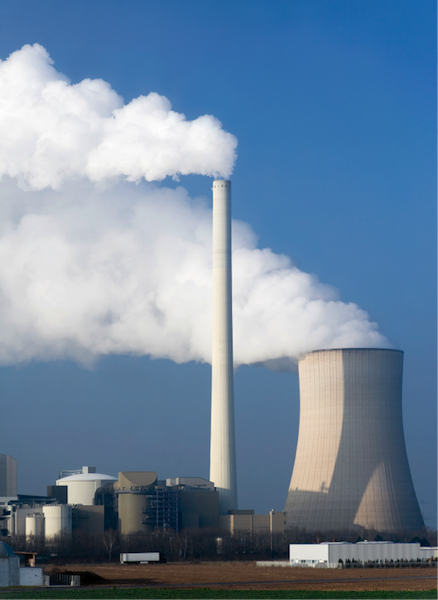
From the above issues, we may notice a few problems. You can’t just produce power thinking it will just be used eventually. At the same time, most of our power does not come from sources you can simply switch on and off. At one extreme, nuclear power is not really turned off, ever. Coal may take approximately 8 hours to fully turn on. Many renewables can’t be used all the time; it might me a cloudy day and the wind may not be blowing.
You can imagine that there is a great deal more electricity used on a summer day than on a winter night. So what do you do? You need to generate extra power for the middle of the day, known as peak demand, when people are working and AC units are on full blast.
So the solution entails much more expensive fuels. The tip of the peak demand for power is generated by burning petroleum fuels. It is a small amount of power but a disproportionally large portion of the emissions related to generating electricity. This means that we need to start thinking about when we use power. Running the washer at 1 PM or 9 PM may use the same amount of power, but the emissions associated are different.

So what can you do?
We won’t propose that you turn the AC off and feel very uncomfortable on the hottest day of the year, but try doing your laundry a little later, maybe run the dishwasher over night, or perhaps turn off your surge protectors. Simply start thinking about which activities can be moved outside the 9AM to 5PM time slot—get creative!
Guest post by Nate Granatir, SAGE Ambassador and Chicago Booth employee
Over the past year, the SAGE Waste & Recycling Committee has begun several initiatives such as improving recycling signage, rethinking the placement of bins at Hutch, and selling “green” Blue Books at the bookstore. But rather than simply harass people about recycling at Earth Fest 2012, we decided we wanted to do something more fun. What we came up with was a game called “Recycling Ninja,” inspired by Fruit Ninja, with which we’ve wasted many hours on our iPhones.
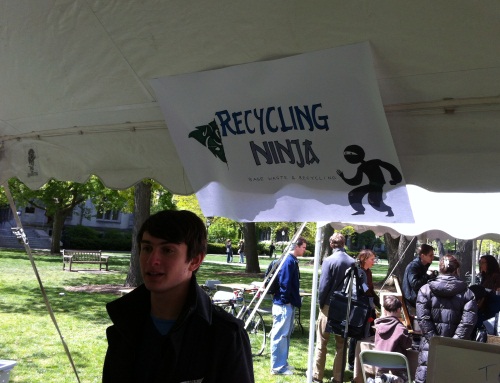
The game was deceptively simple: armed with a large blue recycling bin (and an optional ninja headband), catch all recyclable items but nothing that can’t be recycled. The fun part was actually ours - we hurled as many items as we could at participants for 30 seconds.

The prize for winning? Well, nothing, except a sticker and admiration for placing in the Top 10. If you’d like to be a Recycling Ninja too, look for us at the upcoming Wellness Fair on Wednesday, May 16th, between 11:30am and 1:00pm on the main quad!
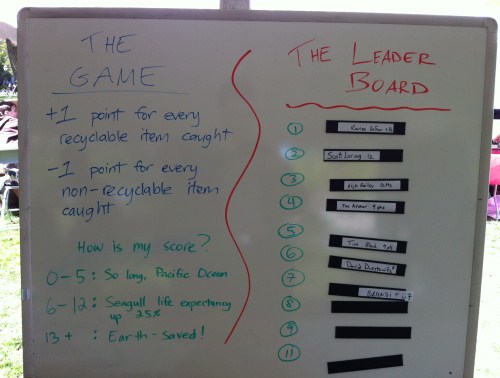
Limited edition Earth Week 2012 Frankenstein t-shirts on sale while supplies last! American Apparel, organic cotton, male and female t-shirts available in sizes small, medium, and large. Only $5—cash or check accepted. Email the Office of Sustainability to place your order and schedule a t-shirt pick-up!
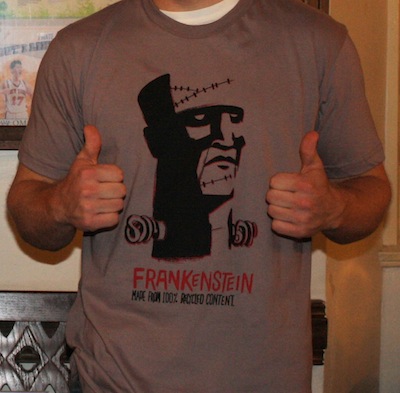
UChicago, as of late, you've been veering away from bottled water and diverting your fair share of food waste from landfills. Green Campus Initiative (GCI) has noticed many of your wonderful efforts, and we wanted to make sure everybody else took notice as well.

Students compost their plates, cups, utensils, and leftover food at the South Asian Students Association Annual Cultural Show on Saturday, March 31.
Thus, we have worked with the Office of Sustainability and ORCSA staff to bring you a brand new Green Event Certification program! The aim of the program is simple: to raise awareness for Registered Student Organizations (RSOs) that are committed to reducing their environmental impacts, and to encourage other RSOs to do so as well.
How does certification work, you might wonder. Well, the process is simple! You perform a self-assessment of and we verify the amount of "green" actions your RSO has taken (in planning an event) by having you fill out a checklist. Each item on the checklist is worth a certain number of points, and if you accumulate 5 points, then you earn certification for your event! If your RSO has taken additional measures that are not mentioned on the checklist, you can detail those actions in a special "Innovation" section and receive points for those deeds as well.
Once you send your completed checklist to greencertification@lists.uchicago.edu, we will verify your "greening" efforts and notify you of your certification achievement. As I mentioned previously, you only need to accumulate 5 points to achieve the SAGE Certified designation. However, if you go above and beyond (by accumulating 8 or more points), your event will receive the honor of SAGE Certified Plus!
After your event is certified, we will send you a special seal that you can display on event advertising and on your RSO website. As an added bonus, we will advertise your event on the GCI listhost and your RSO's greening efforts will be recorded on the Office of Sustainability's website.
So, what are you waiting for? Fill out that checklist and start receiving the recognition you deserve!
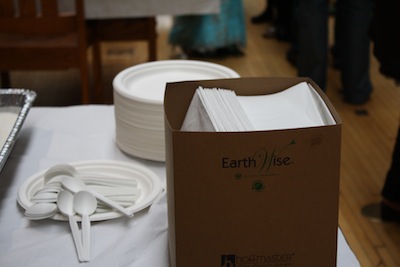
Points towards certification can be earned by purchasing recyclable and compostable tableware (above) and composting all food waste at your event (below).
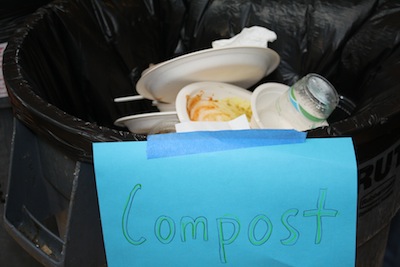
Points can also be earned by serving water in coolers, rather than offering bottled water (below).

Join us Thursday, April 26 for a tour of The Plant, a once abandoned meatpacking facility that is now being repurposed into a net-zero energy vertical farm and food business incubator. See below for details!
When people talk about the future of food, you could hear “I don’t really care,” or “WE ARE ALL GOING TO DIE!!!” or anything in between. Regardless of where you fall on this spectrum, you should check out The Plant. The Plant is a Chicago social enterprise trying something new in a very old building.
Now, allow me to regale you with the story of the Plant.
Let me give you a little snap shot of what goes on.
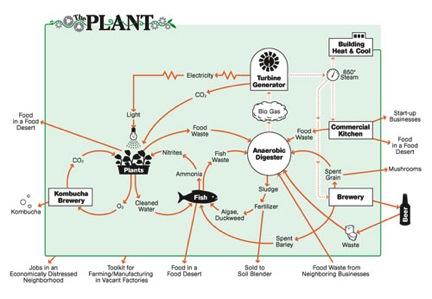
That’s right, The Plant looks like a big food web. Don’t worry, I didn’t read your mind, that’s what we thought too.
The Plant has a celebrated mantra of “The only thing that leaves is food.” We can add beer, fertilizer, jobs, and kombucha to that list, but you get the idea. What we see above is the manifestation of the old adage “One man’s trash is another man’s treasure.” Spent barley from the brewery is used to feed fish; the waste from the fish is fed to plants and used to generate gas, which powers and climate controls the entire building; and so much more.
These beautifully closed loops are made possible by a few major factors.
- Aquaponics By growing plants and fish together, you use up less resources. No more fertilizer purchases, the fish provide nitrates for the plants. The plants in turn clean the water by absorbing a lot of that waste, making the water habitable for the fish.
- Anaerobic gas digestion An anaerobic gas digester uses microbes to turn organic materials, such as food waste, into biogas and nutrient rich sludge. The biogas is then burned to produce steam. The steam then generates electricity and heats/cools the building. The CO2 from burning the biogas can then be pumped to the plants that use it to grow faster.
- Incubating new sustainable businesses This is the kicker. By incubating small sustainable businesses, it becomes possible to close the loops even further. The Plant currently features many artisanal food businesses, including a beer brewery, a bakery, a kombucha (fermented tea) brewery, and a mushroom farm. Spent grain is used to grow mushrooms, food waste from the commercial kitchen goes into the anaerobic digester, the algae and duckweed from the digester is fed to the fish, and more. When we all work together, we all win. In natural systems, there is no waste. Everything is reused and recycled by something else. Everything in a natural system is decomposed and provides sustenance for something else.
Though none of the technologies used are new, it is a rare treat to see them working together. You also don’t get many chances to tour a brewery, an aquaponics system, a mushroom farm, and restaurants at the same time.
Join us on a tour of The Plant during Earth Week, Thursday, April 26, 2:15-4:30 PM. Co-sponsored by Chicago Studies. Please send your RSVP to itagtachian@uchicago.edu by Friday, April 20. Space is limited on this tour.
You don’t want to miss this.
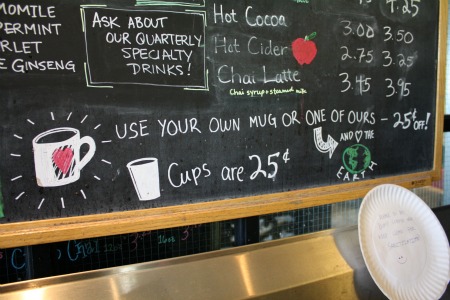
When first arriving in India for study abroad in Fall 2010, students met with the program directors to discuss living at the hotel. At this meeting, a simple question was asked: “Does the hotel recycle?” The room burst into laughter. The answer, in case any naysayers are wondering, was yes—but there was much more to the answer than that. Indians define recycling in a completely different way than we Americans do—they repurpose, recreate, reuse, and upcycle. At our hotel, cleaning fluids were kept in reused water bottles (compared to the U.S. where cleaning fluids are purchased in bottles that are used once and then disposed of) and surplus food from the restaurant was sent home with the employees at the end of the day. In a country of ten billion, where trash pickup is infrequent, reusing becomes the rule, not the exception. I think we have a lot to learn from how Indians perceive trash and how they seem to always think of ways to repurpose things Americans would easily throw away. Here are some lessons from my inner-Indian:
- Check yourself before your wreck yourself/the environment: Before you buy something, consider whether you really need it. Also, think about alternative products—instead of purchasing disposable plastic sandwich bags, invest in a reusable sandwich bag, such as a snack taxi.
Think ahead:
- As you dash out the door in the morning, grab your reusable coffee mug. Many java shops even offer discounts to those who BYOMug Over 16 billion single-use cups are tossed in the trash each year*. The process to make this massive amount of cups wastes enough water to fill 6,000 Olympic-sized swimming pools.
- Stay hydrated by bringing your reusable water bottle with you, everywhere. Not only will you decrease your carbon footprint, you’ll also save a large chunk of change considering that gallon-per-gallon, bottled water is more expensive than gasoline.
- Keep reusable bags in your purse or in your car so they travel with you. Use them if you drop by the grocery or need to transport your Tupperware.
Think outside the box, literally: Take packaging into consideration when you purchase something and when you’re unpacking something new. Keep packaging materials for use later down the line or use things you already have to package items. For gifts, invest in some reusable bags. The website even allows you to track where these bags travel!
- Repurpose: Before you throw something away, or even recycle it, consider its possibilities! In my apartment, we have started a quirky compilation of glass jars as an addition to our drinking glass collection. I also have a couple of plastic truffle trays I use to sort my earrings. Before you chuck it, check it. There’s potential in almost everything!
In the end, it’s best to consider if what you’re tossing in the trash really is trash. Help celebrate the Earth by taking a second to tap into your creative side before throwing something away, because it never really goes “away.”
*source here



